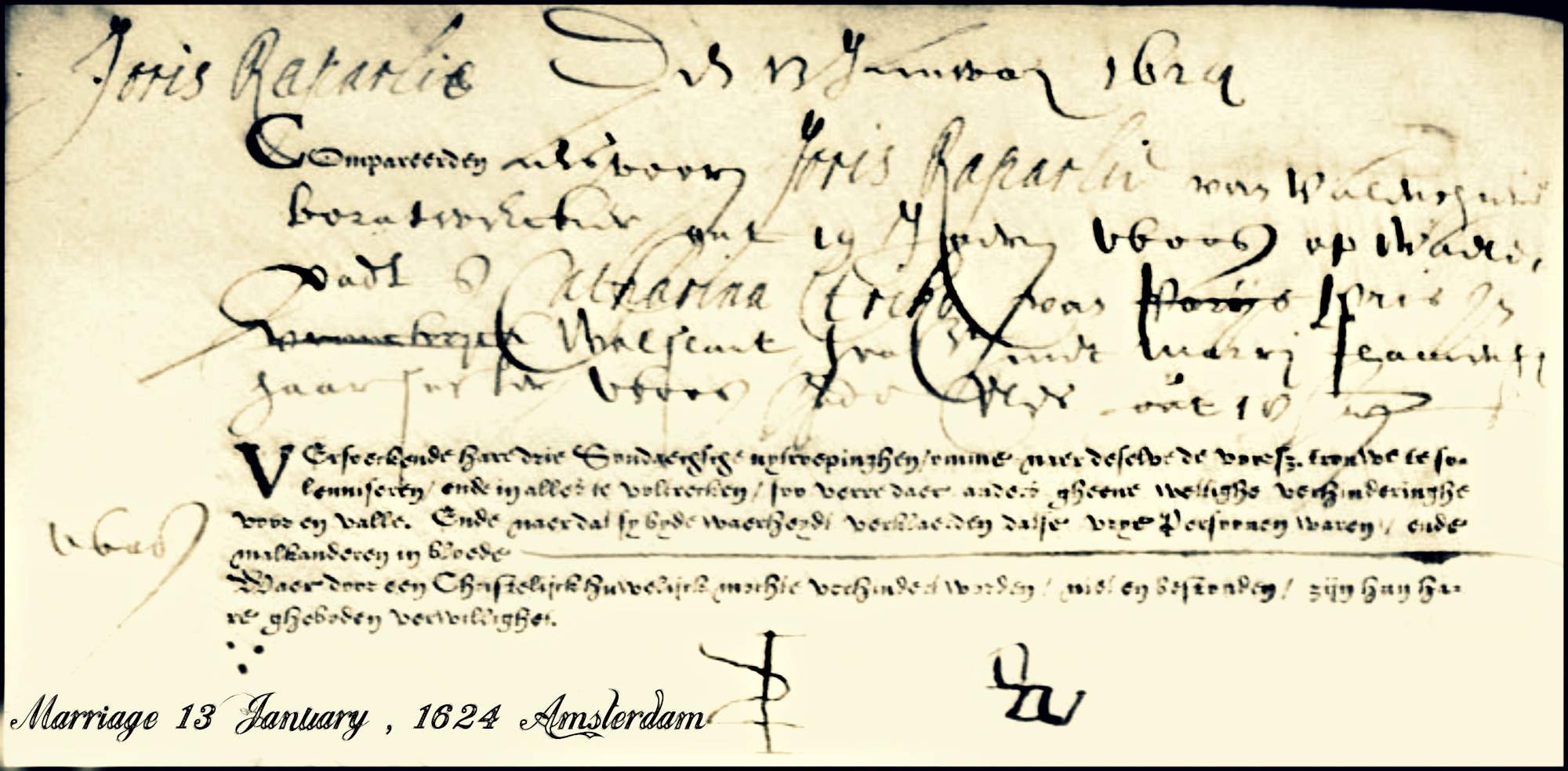
"Netherlands, Noord-Holland Province, Church Records, 1523-1948," images, Nederlands Hervormde > Amsterdam > Huwelijksaangiften, Trouwen 1623-1625 > image 172 of 596; Nederlands Rijksarchiefdienst, Den Haag (Netherlands National Archives, The Hague).
| Spouse | Marriage |
|---|---|
| Catalina Trico (ID: 660,031) | 184 - 660,031 Rapalje - Trico |
Arrived in New Amsterdam in 1623. Stokes. (We show this as 1624 based on modern research.)
Joris Rapelje and Catalina Trico were married 21 January 1624, at the Walloon Church of Amsterdam. Rapelje, an illiterate 19-year-old textile worker whose origin was noted in the registry as 'Valencenne' (Valenciennes, Spanish Netherlands), and his 18-year-bride, had no family present to witness the ceremony. Four days later, on 25 January, the couple departed from Amsterdam, bound for North America.[1] They were traveling aboard the first ships to bring immigrants and workers to New Netherland.
Together they had 11 children including Sara Rapalje, the first child of European descent born in the colony.
Because of the number of their descendants, author Russell Shorto has called Joris Jansen and his wife Catalina "the Adam and Eve" of New Netherland as the number of their descendants has been estimated at about a million.
The Rapalje family were first employed at Fort Orange, in what would eventually become Albany, New York. Fort Orange was being erected by the Dutch West India Company as a trading post on the west bank of the Hudson River. It became the company's official outpost in the upper Hudson Valley. The families aboard these ships were principally Walloons, French-speaking residents of Valenciennes, Roubaix, Hainaut and related sites, now in Belgium's province of Wallonia and France's region of Nord-Pas-de-Calais, but then part of the Spanish Netherlands.[2]
By 1626, Dutch authorities had relocated most settlers from Fort Orange to Fort Amsterdam at the southern end of Manhattan Island. The Rapeljes established a residence near the East River, and were among the earliest purchasers of land in Manhattan, later building two houses on Pearl Street near the Fort. In 1637, Rapalje purchased about 335 acres (1.36 km2) around Wallabout Bay in what is now Brooklyn. His son-in-law Hans Hansen Bergen acquired a large tract adjoining Rapelje's tract. Today the land where the Rapalje's farm stood is the Brooklyn Navy Yard. In 1641, Rapalje was one of the Council of Twelve Men representing Manhattan, Breukelen and Pavonia. From 1655 through 1660, he was a magistrate of Brooklyn.[3] He died in Breuckelen, New Netherland.[4]
Brooklyn's Rapelye Street is named for the family. The spelling of the Rapelje family name varied over the years to include Rapelye, Rapalje, Rapareilliet, Raparlié, Rapalyea, Raplee, Rapelyea, Rapeleye, Rappleyea as well as others.[6]
https://en.wikipedia.org/wiki/Joris_Jansen_Rapelje
Arrived on the Unity. See ship journeys 1624 - Unity.

